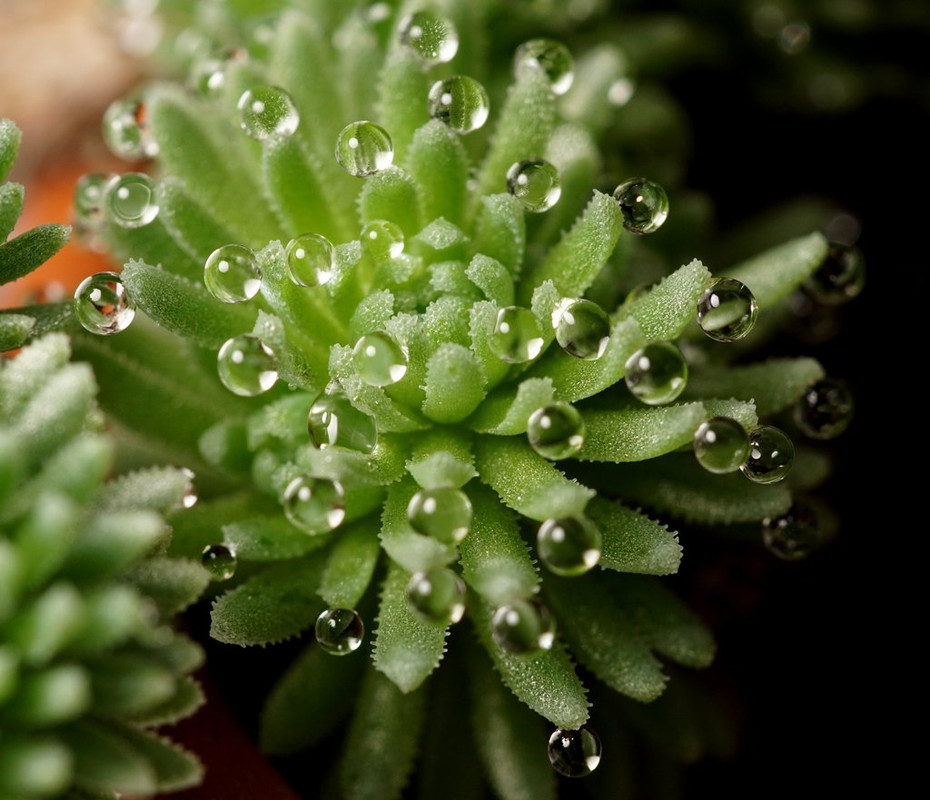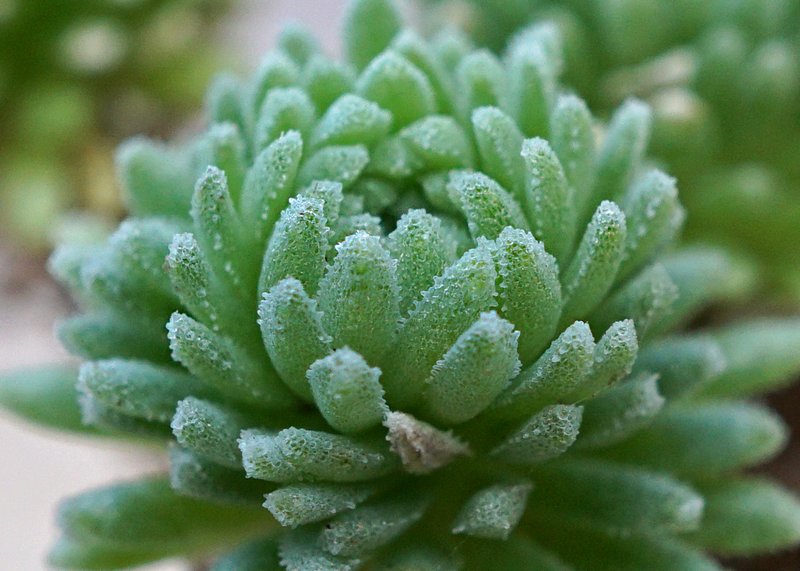
What is the purpose of leaf papillae?
Forum rules
For the discussion of topics related to the conservation, cultivation, propagation, exhibition & science of cacti & other succulents only.
Please respect all forum members opinions and if you can't make a civil reply, don't reply!
For the discussion of topics related to the conservation, cultivation, propagation, exhibition & science of cacti & other succulents only.
Please respect all forum members opinions and if you can't make a civil reply, don't reply!
-
wildedges
- Registered Guest
- Posts: 197
- https://www.behance.net/kuchnie-warszawa
- Joined: 13 Nov 2018
- Branch: None
- Country: uk
What is the purpose of leaf papillae?
A broad question I know but specifically I'm doing some reading up on Sedum multiceps at the moment and it's described as having papillose/papillate leaves (defined as 'covered in nipples' apparently). The macro photo below shows the papillae which tend to just be along the edges and tips of the leaf. I can see that they increase the surface area of the leaf. They might aid in trapping airborne moisture or act as a bit of sun protection or insulation but I can't find a definitive answer in this case. They also look as if they lock together like teeth when the rosettes close up so may act to prevent pests squeezing between the leaves.


Re: What is the purpose of leaf papillae?
Lots of views and no replies so I guess I should expand on my question a bit.
Sedum multiceps is a winter growing plant from an area that can have very dry but not dramatically hot summers. It has adapted to summer sun and drought by allowing the lower leaves to dry up so that only the last few terminal leaves are left alive, as in the photo below. The dead leaves wrap the stem and living leaves to provide them with shelter, and are always retained on the plant. The plant seems to be able to survive even when no green is left visible.
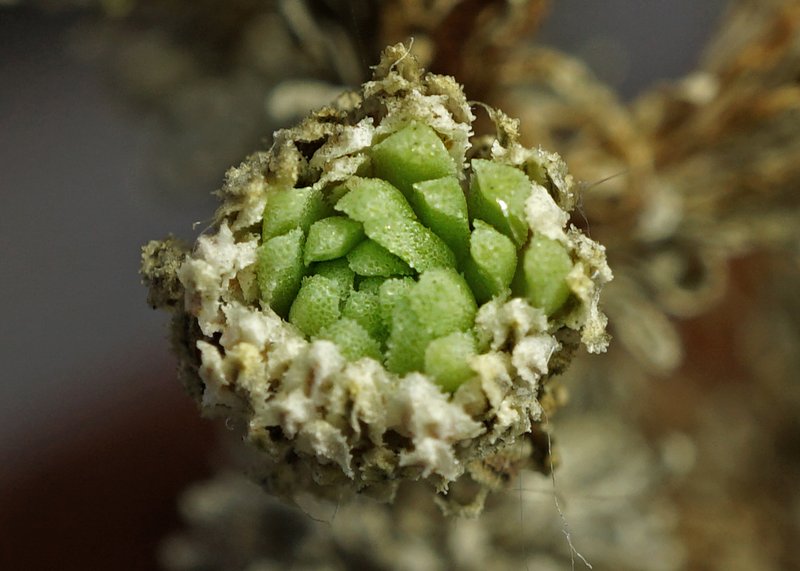
When the plant is left with just the tightly wrapped rosette of leaves you can see that the papillae clustered at the leaf tips would offer quite a bit of sun protection. They can actually be tricky to photograph because of the light reflecting off the papillae.
The rosette seems to open up again as new leaves start to grow from the centre. The photo below is one just opening at the moment after the summer.
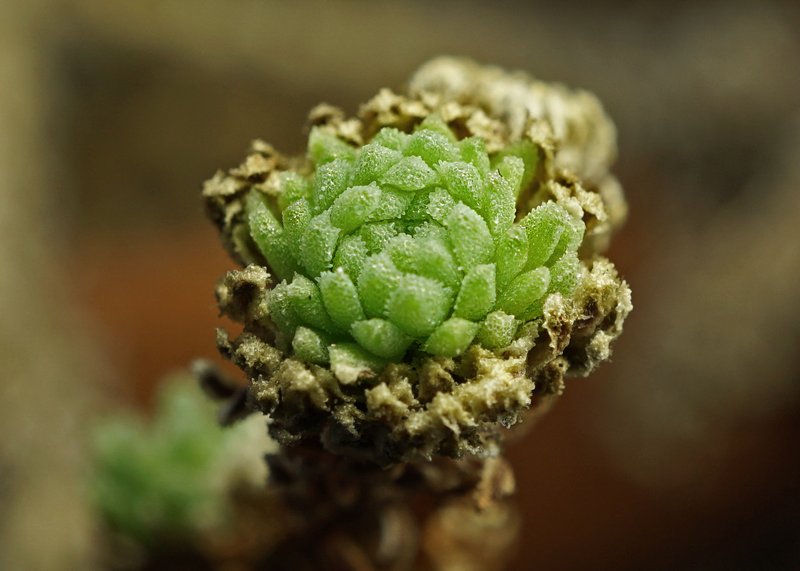
It seems to go into this summer dormancy around the time of flowering which suggests it uses the resources in the leaves to help grow the inflorescences. Plants that don't flower don't seem to close up as much, based on my limited growing experience.
I've been looking at the more mountainous habitats of the plant though and I've found a few records of the areas where it grows to elevation above 1500m. These areas get quite a bit of snow and cold weather so I'm wondering if the leaf structure is also to help with resistance to freezing. Climate data suggests fog isn't a very common occurrence and if it does happen then it's at a time of year when there's sufficient rain anyway so I'm guessing these aren't to help collect moisture, even if the plant seems to favour very rocky coastal areas.
I'm probably just thinking out loud but maybe someone can correct my assumptions or offer more expert knowledge?
Sedum multiceps is a winter growing plant from an area that can have very dry but not dramatically hot summers. It has adapted to summer sun and drought by allowing the lower leaves to dry up so that only the last few terminal leaves are left alive, as in the photo below. The dead leaves wrap the stem and living leaves to provide them with shelter, and are always retained on the plant. The plant seems to be able to survive even when no green is left visible.

When the plant is left with just the tightly wrapped rosette of leaves you can see that the papillae clustered at the leaf tips would offer quite a bit of sun protection. They can actually be tricky to photograph because of the light reflecting off the papillae.
The rosette seems to open up again as new leaves start to grow from the centre. The photo below is one just opening at the moment after the summer.

It seems to go into this summer dormancy around the time of flowering which suggests it uses the resources in the leaves to help grow the inflorescences. Plants that don't flower don't seem to close up as much, based on my limited growing experience.
I've been looking at the more mountainous habitats of the plant though and I've found a few records of the areas where it grows to elevation above 1500m. These areas get quite a bit of snow and cold weather so I'm wondering if the leaf structure is also to help with resistance to freezing. Climate data suggests fog isn't a very common occurrence and if it does happen then it's at a time of year when there's sufficient rain anyway so I'm guessing these aren't to help collect moisture, even if the plant seems to favour very rocky coastal areas.
I'm probably just thinking out loud but maybe someone can correct my assumptions or offer more expert knowledge?
-
edds
- BCSS Member
- Posts: 2871
- Joined: 09 Dec 2019
- Branch: None
- Country: United Kingdom
- Role within the BCSS: Member
Re: What is the purpose of leaf papillae?
It's not unusual to get a lot of views but people will be taking it in and thinking about it.
A quick Google suggested that they have a role in a certain species in salt tolerance but I'm not sure that would be needed in this species. If it was sun protection in the leaf tips when closed I'd expect them to be more localised to the tips and also hairs and powdery reflective surfaces do a better job of that than papillae and would lose less water than papillae which increase the leaf's surface area, potentially speeding up transpiration!
A quick Google suggested that they have a role in a certain species in salt tolerance but I'm not sure that would be needed in this species. If it was sun protection in the leaf tips when closed I'd expect them to be more localised to the tips and also hairs and powdery reflective surfaces do a better job of that than papillae and would lose less water than papillae which increase the leaf's surface area, potentially speeding up transpiration!
Ed
BCSS member 53038
BCSS member 53038
- ChrisR
- BCSS Member
- Posts: 2054
- Joined: 11 Jan 2007
- Branch: SHEFFIELD
- Country: England
- Role within the BCSS: Member
- Location: Sheffield, UK
Re: What is the purpose of leaf papillae?
I would also like to know but I don't think there's a definitive answer. Lot of crassulas have papillae too. One theory is that it could be a mechanism developed for collecting moisture from mist and fog, but as other none papillate taxa exist in the same areas, it's an unlikely reason.
Chris Rodgerson- Sheffield UK BCSS 27098
See www.conophytum.com for ca.4000 photos and growing info on Conophytum, Crassula & Adromischus.
See www.conophytum.com for ca.4000 photos and growing info on Conophytum, Crassula & Adromischus.
Re: What is the purpose of leaf papillae?
My research is ongoing but I've taken a photo that show the papillae at the margins of the leaves and another in profile to show the smooth surface front and back. It's very similar to an aloe leaf in structure when you look at them closely. I could really use a microscope for a better look though.

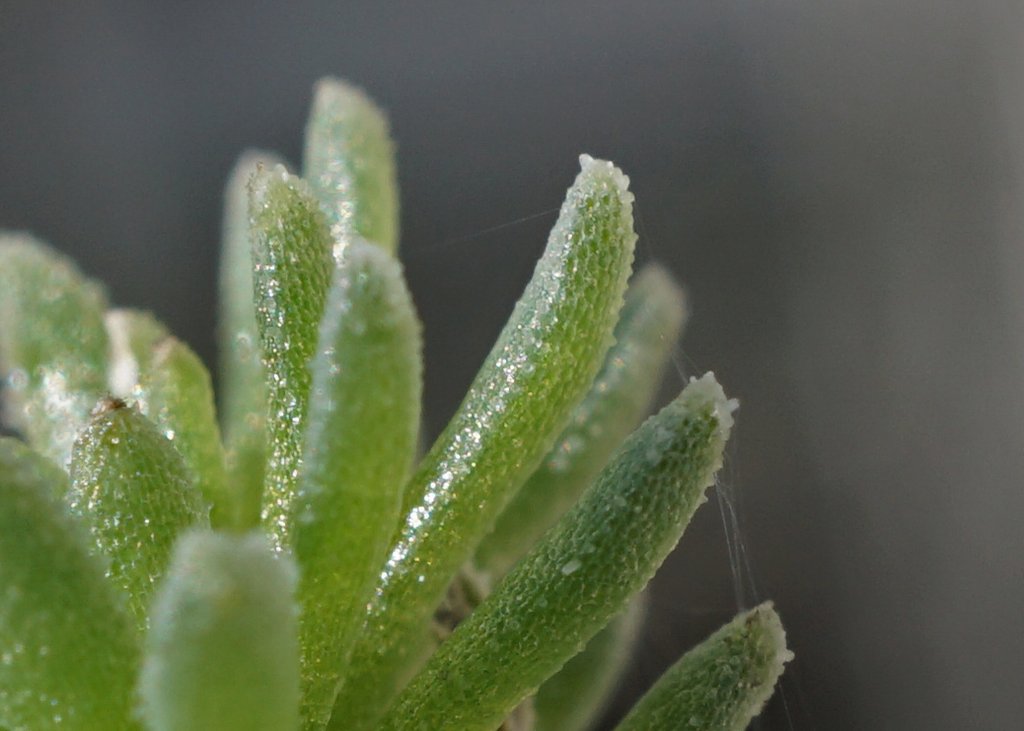
I found a paper on similar features in Haworthia that suggests the papillae on those are multi-layered epidermal cells with practically no chlorophyll and that stomata are only present in single-layered epidermis. In the haworthia that were studied the cells were found to function mostly to provide micro-shading effects that reduces over-heating and slows transpiration. So it's a way of increasing leaf surface area without increasing the amount of stomata. The papillae are translucent so I imagine they filter direct sunlight rather than block it completely. It's also interesting that the plant doesn't shed the dead leaves so they cling to the stem and still provide the shading effect even after death.


I found a paper on similar features in Haworthia that suggests the papillae on those are multi-layered epidermal cells with practically no chlorophyll and that stomata are only present in single-layered epidermis. In the haworthia that were studied the cells were found to function mostly to provide micro-shading effects that reduces over-heating and slows transpiration. So it's a way of increasing leaf surface area without increasing the amount of stomata. The papillae are translucent so I imagine they filter direct sunlight rather than block it completely. It's also interesting that the plant doesn't shed the dead leaves so they cling to the stem and still provide the shading effect even after death.
- ChrisR
- BCSS Member
- Posts: 2054
- Joined: 11 Jan 2007
- Branch: SHEFFIELD
- Country: England
- Role within the BCSS: Member
- Location: Sheffield, UK
Re: What is the purpose of leaf papillae?
While getting into Crassula and reading Töken's descriptions, I wondered about the difference between hairs and papillae. Crassula sericea and it's subsp.hottentotta differ only by having hairs or papillae. On some the difference is obvious but on others, not so much. High magnification is necessary to see the difference on those. They both grow in similar habitat so I can discern no reason for the difference.
Chris Rodgerson- Sheffield UK BCSS 27098
See www.conophytum.com for ca.4000 photos and growing info on Conophytum, Crassula & Adromischus.
See www.conophytum.com for ca.4000 photos and growing info on Conophytum, Crassula & Adromischus.
Re: What is the purpose of leaf papillae?
That's fascinating and really helpful thanks. What did you use to get those high magnification photos by the way?
Re: What is the purpose of leaf papillae?
https://www.researchgate.net/publicatio ... ern_Africa
It does look like there could be a link to water collection from airborne moisture according to the abstract for this paper. This refers to Namibian Crassula rather than the sedum but it still helps to answer my question.
It does look like there could be a link to water collection from airborne moisture according to the abstract for this paper. This refers to Namibian Crassula rather than the sedum but it still helps to answer my question.
- Paul in Essex
- BCSS Member
- Posts: 2099
- Joined: 11 Jan 2007
- Branch: SOUTHEND-ON-SEA
- Country: England
- Role within the BCSS: Member
- Location: North Thames Delta
- Contact:
Re: What is the purpose of leaf papillae?
I can add absolutely nothing to this discussion but I am moved to say I'm really enjoying the pictures! 
Re: What is the purpose of leaf papillae?
I just thought I'd add this photo as I've noticed my plants collecting a lot of dew drops in this wet weather. They're basically self-watering at this point but I need to move them to the other greenhouse which gets much better ventilation.
